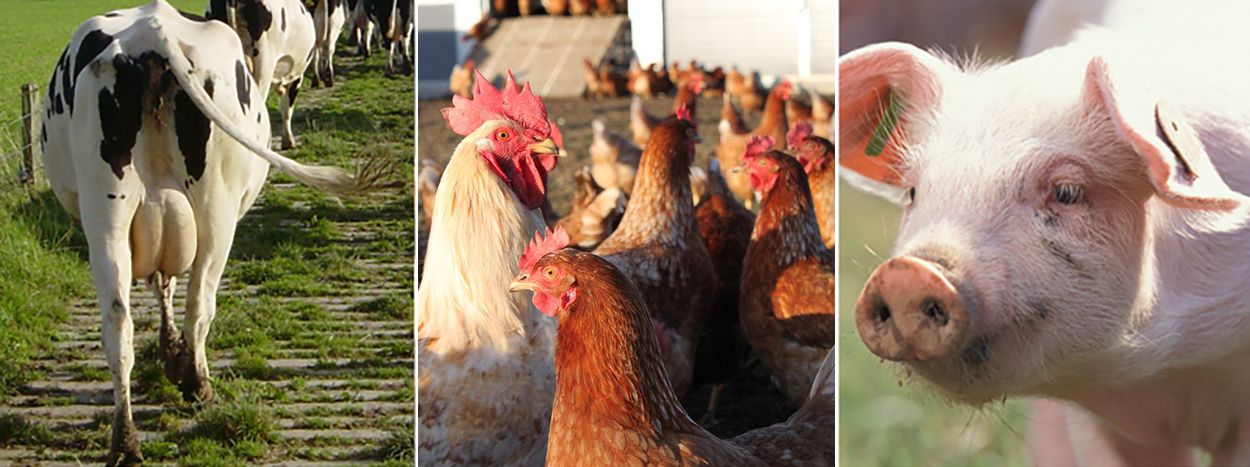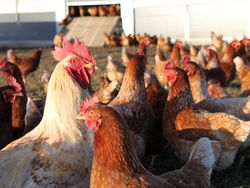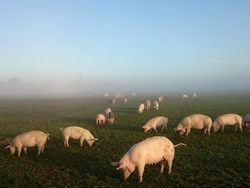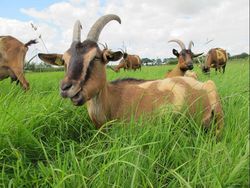Dossier
Special features of animal husbandry in organic farming
Solveig March | 01.06.2022
The ideal of organic farming is a closed nutrient cycle between soil, plants and animals. Animal husbandry is tied to the land, i.e. the farm itself should be the basis for both fodder and nutrients.

In order not to pollute soil, groundwater and surface waters, the number of animals on the area is limited. The maximum permissible number of animals may not exceed two livestock units per hectare or 170 kg nitrogen equivalent. The following table shows by way of example how many animals this is, depending on the type of animal:
Animal species | Permitted number/ha |
|---|---|
Horses, Donkeys (> 6 months) | 2 |
Calves for fattening | 5 |
Dairy cows | 2 |
Ewes/goats | 13,3 |
Breeding sows | 6,5 |
Pigs for fattening | 14 |
Laying hens | 230 |
As a rule, feed must be organically grown. However, it is permissible for up to a maximum of 30 % of the average feed ration to consist of in-conversion feed. Before crop products may be labelled organic, the farm's cultivated areas must undergo a period of conversion during which the rules of organic farming are already being observed. The crops produced during this period that are fed are considered conversion feed. If they come from the farm itself, up to 100 % in-conversion feed is allowed.
Currently, the use of protein feeds of non-organic origin is permitted in the feeding of young pigs and poultry to the extent of 5 % ration share by means of temporary derogations (EU Organic Regulation No. 2020/464 paragraph 13).
All animals must be fed roughage (at least 60% of the dry matter of the daily ration in the case of ruminants) and the aim is for large proportions to come from the farm itself (at least 60% in the case of herbivores, at least 20% in the case of monogastric animals such as pigs and chickens).
Young mammals must be reared on natural milk, preferably their mother's milk. Calves must be fed milk for at least three months, sheep and goat kids for 45 days and piglets for 40 days.
The housing of the animals should allow them to behave in a manner appropriate to their species, so there are a number of requirements concerning the design of the housing environment and management:
- The animals should have the possibility to stay outside, i.e. they should have permanent access to open air areas. Ruminants should be allowed to graze as much as possible.
- The space available per animal in the barn and in the run must comply with the specifications in organic farming, which clearly exceed those in conventional livestock farming.
- The lying areas must be provided with sufficient dry bedding. The floors in the barns must not be fully slatted.
- Medicines must not be administered prophylactically and non-curative interventions, e.g. trimming the beaks of poultry or docking the tails of piglets, must not be carried out systematically on the animals.
- Good animal health should be achieved through preventive measures where possible.
- In the case of veterinary treatment, the prescribed waiting period between the treatment of the animal and the production of organic food is twice as long as in conventional animal husbandry.
- The administration of performance-enhancing substances is prohibited. In contrast to conventional animal husbandry, the administration of hormones for the systematic synchronisation of oestrus, which can be used to achieve a timely pregnancy of a group of animals more easily, e.g. in dairy cows or breeding sows, is also prohibited.
In organic farming, the use of genetic engineering and products produced from or by genetically modified organisms (GMOs) is prohibited. They may not be used as food, feed, processing aids, plant protection products, fertilisers, soil conditioners, seeds, vegetative propagation material, micro-organisms or animals in the production of organic products. Veterinary medicinal products are exempt from this prohibition.
Further information
Zahlen, Daten, Fakten des Bund Ökologische Lebensmittelwirtschaft BÖLW) (in German)
Ökolandbau (Daten der AMI (Agrarmarkt Informations-Gesellschaft mbH))
Steckbriefe zur Tierhaltung in Deutschland: Aktuelle Zahlen, Daten und Fakten zur Tierhaltung (in German)










